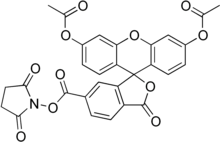Carboxyfluorescein diacetate succinimidyl ester
 | |
| Names | |
|---|---|
| Preferred IUPAC name 2,5-Dioxopyrrolidin-1-yl 3′,6′-bis(acetyloxy)-3-oxo-3H-spiro[[2]benzofuran-1,9′-xanthene]-6-carboxylate | |
| Other names CFDA-SE Carboxyfluorescein diacetate N-succinimidyl ester | |
| Identifiers | |
| |
3D model (JSmol) |
|
| ChemSpider | |
PubChem CID |
|
| UNII | |
CompTox Dashboard (EPA) |
|
| |
| |
| Properties | |
| C29H19NO11 | |
| Molar mass | 557.467 g·mol−1 |
Except where otherwise noted, data are given for materials in their standard state (at 25 °C [77 °F], 100 kPa). | |
Carboxyfluorescein diacetate succinimidyl ester (CFDA-SE) is an amine-reactive, cell-permeable dye generally used in animal cell proliferation research. CFDA-SE is a modified CFSE with two hydroxyl groups on its fluorescein moiety replaced with acetates. This change renders the molecule more hydrophobic and cell-permeable at the expense of its fluorescence property. After entering cells by diffusion, CFDA-SE is cleaved by intracellular esterase enzymes to form CFSE. As its reactive succinimidyl ester group is unmodified, CFDA-SE also covalently binds to lysine residues and other amine sources like CFSE.
If a stained cell divides, the dye is divided equally between the two daughter cells, resulting in both new cells having a CFDA-SE concentration approximately 50% that of the mother cell. A cell stained with CFDA-SE can be kept in culture for several days and fluorescence is detectable in cells following up to 8 successive cell divisions. Fluorescence is typically detected using a flow cytometer on the FL1 detector, with each resulting fluorescent peak representing another round of cell division. The area of each peak is representative of the number of cells in a given division cycle. The staining works best with relatively homogeneous cell populations.
High concentrations of the dye are toxic to animal cells; however, concentrations in the region of 10 micromolar are typically sufficient to give strong staining with minimal cell death. Most cell types will excrete a proportion of the dye over the course of the first 24–48 hours following staining. Dye levels should thereafter remain relatively stable in non-dividing cells.
CFDA-SE is often erroneously referred to as CFSE, even in scientific literature.[1]
See also
References
- ^ Cell Lab Quanta SC Archived March 15, 2007, at the Wayback Machine
